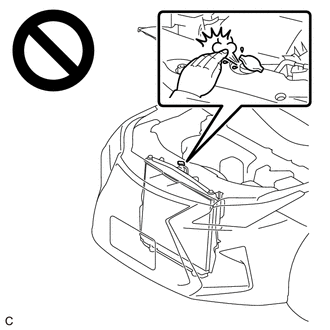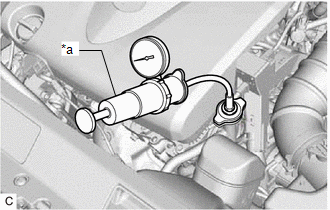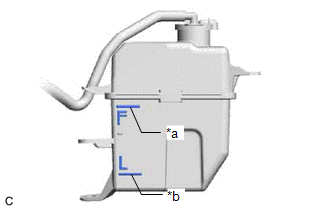Toyota Camry (XV70): Cooling System
On-vehicle Inspection
ON-VEHICLE INSPECTION
CAUTION / NOTICE / HINT
CAUTION:
Do not remove the radiator cap sub-assembly while the engine and radiator assembly are still hot. Pressurized, hot engine coolant and steam may be released and cause serious burns.

PROCEDURE
1. INSPECT FOR COOLANT LEAK
CAUTION:
Do not remove the radiator cap sub-assembly while the engine and radiator assembly are still hot. Pressurized, hot engine coolant and steam may be released and cause serious burns.
(a) Remove the radiator cap sub-assembly.
| (b) Fill the radiator assembly with engine coolant, and then install a radiator cap tester. |
|
(c) Warm up the engine.
(d) Pump the radiator cap tester to 122 kPa (1.2 kgf/cm2, 18 psi), and then check that the pressure does not drop.
- If the pressure drops, check the hoses, radiator assembly and engine water pump assembly for leaks.
- If there are no signs of external engine coolant leaks, check the heater core, cylinder block sub-assembly and cylinder head sub-assembly.
(e) Remove the radiator cap tester.
(f) Install the radiator cap sub-assembly.
2. INSPECT ENGINE COOLANT LEVEL IN RESERVOIR TANK
| (a) Check that the engine coolant level is between the L line and F line when the engine is cold. If the engine coolant level is low, check for leaks and add engine coolant to the F line. NOTICE: Do not substitute plain water for engine coolant. |
|
3. INSPECT ENGINE COOLANT QUALITY
CAUTION:
Do not remove the radiator cap sub-assembly while the engine and radiator assembly are still hot. Pressurized, hot engine coolant and steam may be released and cause serious burns.
(a) Remove the radiator cap sub-assembly.
(b) Check if there are any excessive deposits of rust or scale around the radiator cap sub-assembly and water filler hole. Also, the engine coolant should be free of oil.
If excessively dirty, replace the engine coolant.
(c) Install the radiator cap sub-assembly.



